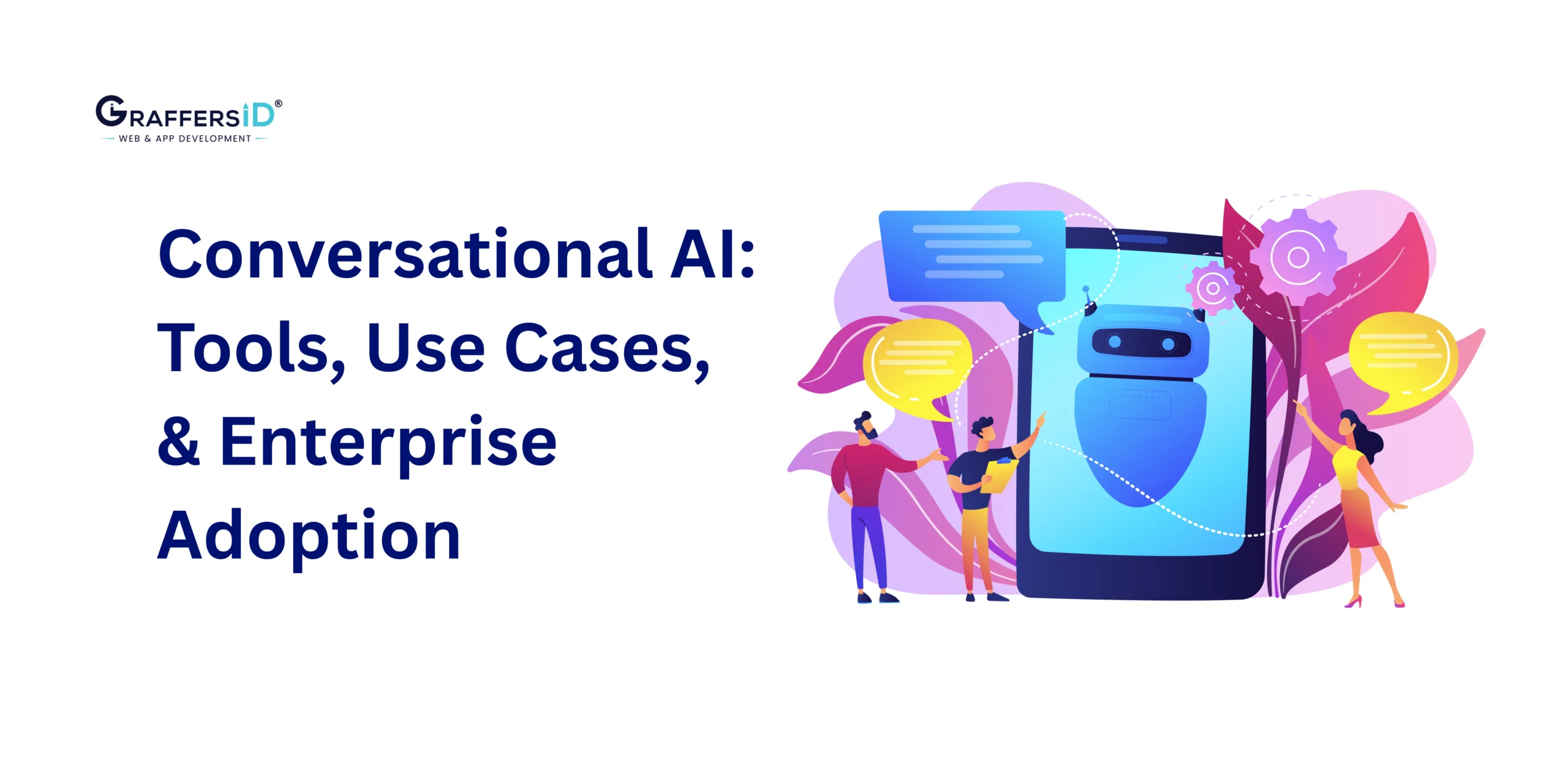In the dynamic realm of web development and application programming, the choice between stateful and stateless APIs is akin to selecting the right tool for a specific job. Understanding the nuances between these two approaches is crucial for developers seeking to optimize performance, scalability, and overall efficiency. Let’s explore to demystify the intricate world of stateless vs stateful
API.
What Are Stateful APIs?
Stateful APIs, as the name suggests, maintain a record of the current state of the client’s interactions. In simpler terms, these APIs remember past interactions and use the context of those interactions to process subsequent requests. The server keeps track of the client’s state, enabling a seamless continuation of conversations.
Imagine a user logging into an application. In a stateful API, the server remembers the user’s login information and maintains it throughout the session. This persistent connection between the client and server facilitates a smoother exchange of information, making it ideal for applications that require continuous user engagement.
Read More: How to Build Secure APIs with Node.js for Remote Applications
Different Types of Stateful APIs
Stateless APIs are designed to treat each request independently without storing any session information, stateful APIs maintain state information between requests. In this article, we’ll delve deeper into the various types of stateful APIs and their applications.
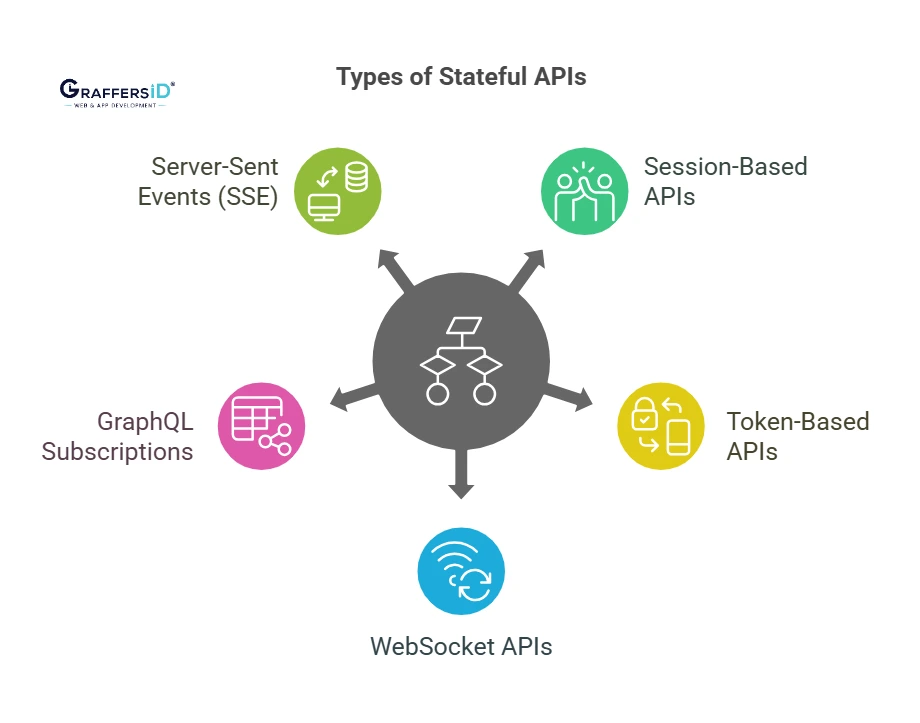
1. Session-Based APIs:
Session-based APIs are perhaps the most common type of stateful APIs. They maintain a session state on the server side, usually using cookies or tokens sent by the client during authentication. Once a session is established, the server can keep track of user-specific data throughout multiple requests. This is particularly useful for applications that require users to log in and perform multiple actions within a single session, such as e-commerce platforms, social media sites, and banking applications.
2. Token-Based APIs:
Token-based APIs rely on tokens generated by the server and sent to the client upon successful authentication. These tokens, often in the form of JSON Web Tokens (JWTs), contain encoded information about the user or client session. Unlike traditional session-based APIs that store session data on the server, token-based APIs store the necessary session information in the token itself. This makes them highly scalable and suitable for distributed systems where sessions need to be validated without relying on server-side storage.
3. WebSocket APIs:
WebSocket APIs represent a different paradigm compared to traditional HTTP-based APIs. While HTTP is inherently stateless, WebSocket provides a full-duplex communication channel that allows for persistent connections between the client and server. This persistent connection enables real-time data exchange and bi-directional communication, making WebSocket APIs ideal for applications like online gaming, chat applications, and live streaming services where low-latency communication and real-time updates are crucial.
4. GraphQL Subscriptions:
GraphQL, a query language for APIs, introduced the concept of subscriptions to facilitate real-time data updates. Subscriptions enable clients to subscribe to specific data events on the server, and the server pushes updates to the subscribed clients whenever relevant data changes occur. This approach is highly efficient for building reactive and real-time applications such as dashboards, live feeds, and collaborative tools where instant data updates are vital for user experience.
5. Server-Sent Events (SSE):
Similar to WebSocket APIs, Server-Sent Events (SSE) allow servers to push updates to clients over a single, long-lived HTTP connection. However, SSE is specifically designed for one-way communication from the server to the client. This makes SSE well-suited for scenarios where the server needs to continuously send updates or notifications to clients, such as news feeds, real-time monitoring systems, and live scoreboards.
What Are Stateless APIs?
In contrast, stateless APIs operate without the burden of remembering past interactions. Each request from the client to the server is independent and self-contained. The server treats every request as a new, isolated transaction, devoid of any knowledge about preceding interactions.
Stateless APIs are like transient messengers – they deliver a message (request), the server processes it, and the communication concludes. This design principle simplifies the server’s responsibilities, promoting scalability and easing the burden of maintaining session information. Let’s know the detailed difference between stateful and stateless APIs.
Different Types of Stateless APIs
Stateless APIs are designed to be lightweight, scalable, and easily cacheable, making them ideal for distributed systems and cloud-based architectures where scalability and performance are critical factors.
Now, let’s explore the different types of stateless APIs:
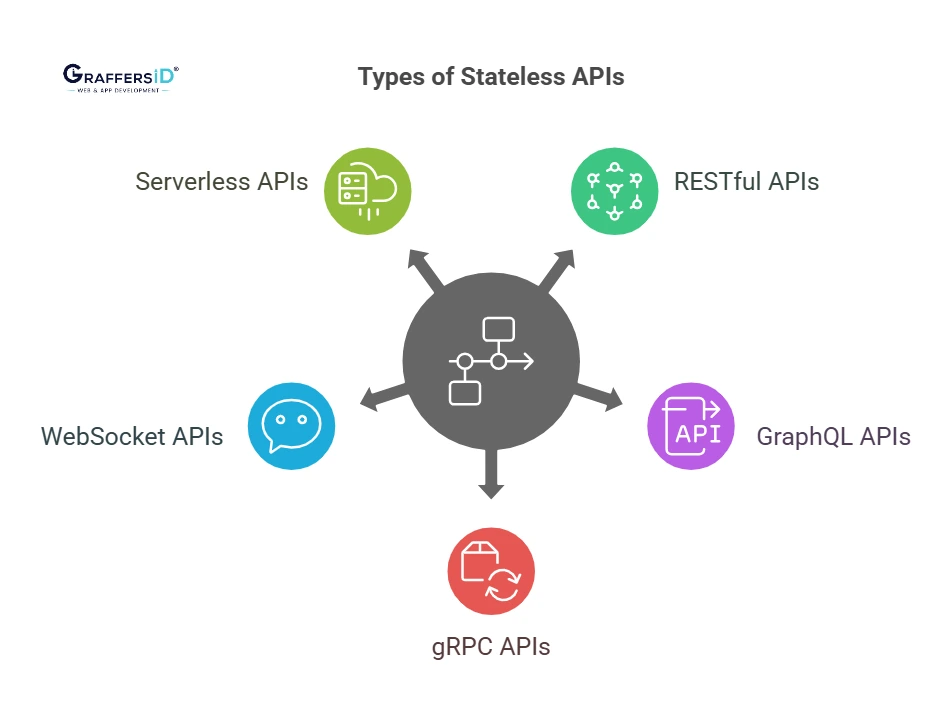
1. RESTful APIs
REST (Representational State Transfer) is a popular architectural style for designing networked applications. RESTful APIs, also known as REST APIs, adhere to the principles of REST and use standard HTTP methods like GET, POST, PUT, DELETE, etc., to perform CRUD (Create, Read, Update, Delete) operations on resources.
One of the key characteristics of RESTful APIs is their statelessness. Each request sent to a RESTful API contains all the information necessary for the server to process it, and there’s no need for the server to maintain session state between requests. This makes RESTful APIs highly scalable and suitable for distributed environments.
2. GraphQL APIs
GraphQL is a query language for APIs that allows clients to request only the data they need. Unlike traditional REST APIs where the server defines the structure of the response, GraphQL APIs enable clients to specify the shape and structure of the data they require, reducing over-fetching and under-fetching of data.
GraphQL APIs can be designed to be stateless by ensuring that each GraphQL query contains all the information needed to fulfill the request. Since clients explicitly specify their data requirements, there’s no need for the server to maintain client session state between requests.
3. gRPC APIs
gRPC is a high-performance RPC (Remote Procedure Call) framework developed by Google. It uses HTTP/2 for transport and Protocol Buffers (protobuf) for serialization, making it efficient for communication between microservices and distributed systems.
gRPC APIs can be designed to be stateless by treating each RPC call as an independent request. Since gRPC uses HTTP/2, it benefits from features like multiplexing, header compression, and stream processing, making it ideal for building fast and scalable APIs.
4. WebSocket APIs
While traditional HTTP-based APIs are stateless by nature, WebSocket APIs provide a stateful, full-duplex communication channel between clients and servers. Unlike HTTP, which follows a request-response model, WebSocket allows for real-time, bi-directional communication where both clients and servers can initiate data exchange.
Although WebSocket APIs maintain a persistent connection, they can still be designed to be stateless by ensuring that each message sent over the WebSocket contains all the necessary information for processing. WebSocket APIs are commonly used in applications requiring real-time updates, such as chat applications, online gaming, and collaborative tools.
5. Serverless APIs
Serverless computing has gained popularity for its scalability, cost-effectiveness, and ease of deployment. Serverless APIs, built using serverless platforms like AWS Lambda, Azure Functions, or Google Cloud Functions, follow a stateless architecture where each function invocation is independent of previous invocations.
Serverless APIs handle requests on a per-invocation basis, and the underlying serverless platform manages the scalability and resource allocation. Since serverless functions are stateless by design, they can scale horizontally without the need to maintain a session state, making them well-suited for event-driven architectures and microservices.
Difference Between Stateless vs Stateful API
| Feature | Stateful APIs | Stateless APIs |
|---|---|---|
| Maintaining State | Maintain the client state between requests. This is often achieved through session management. Allows the server to remember previous requests and respond accordingly. | Do not store the client state on the server between requests. Each request from the client is treated as an independent and isolated transaction, with no knowledge of prior requests. |
| Server Dependency | Rely on server-side storage to maintain client state. This can include databases or in-memory storage for session data. | Do not have a server-side storage dependency for the client states, making them easier to scale horizontally without the need for a shared state among server instances. |
| Scalability | Can be less scalable, especially when the number of clients increases, as the server needs to manage and synchronize state across multiple instances. | More scalable since each request is independent, and servers can handle requests in parallel without worrying about shared state. |
| Performance Impact | Higher performance impact due to the overhead of managing and persisting client states. | Lower performance impact since each request is self-contained, reducing the need for extensive state management and synchronization. |
| Request Handling | Often less data is transmitted in each request, as the server and client share contextual information through session data. | Transmit all necessary information with each request, making each request independent and reducing the reliance on a shared state. |
| Flexibility | Less flexible when clients change or need to scale rapidly, as changes in state management may require adjustments on both the server and client sides. | More flexible, allowing clients to evolve independently without affecting the server, making them well-suited for distributed and microservices architectures. |
| Resource Usage | Use more resources as servers need to maintain and manage session data, leading to increased storage and processing requirements. | Use fewer resources, as there is no need for server-side storage of client state between requests. This can result in more efficient resource utilization. |
| Fault Tolerance | Require additional measures for fault tolerance, such as redundant session storage or failover mechanisms, to ensure continuous operation in case of server failures. | Offer better fault tolerance as each request is independent. If one server fails, another can seamlessly take over, and clients can continue making requests without disruption. |
| Example | Traditional web applications that use sessions, such as e-commerce sites require user authentication and maintaining a shopping cart state. | RESTful APIs, where each request is stateless, make them suitable for web services, mobile applications, and distributed systems that prioritize simplicity, scalability, and independence between requests. |
Advantages and Disadvantages of Stateful APIs

The debate surrounding stateful and stateless APIs continues to captivate the attention of developers and tech enthusiasts alike. While stateless APIs are praised for their simplicity and scalability, stateful APIs offer a different approach, providing persistence and context retention. In this comprehensive exploration, we’ll delve into the intricacies of stateful APIs, shedding light on their multifaceted advantages and disadvantages to empower you in making informed decisions for your projects.
Advantages of Stateful APIs:
1. Context Retention:
Stateful APIs excel in maintaining context across multiple requests. This allows for a more seamless user experience, as the server can remember previous interactions, reducing the need for redundant data submissions. For applications where maintaining state is crucial, such as in multi-step workflows or e-commerce transactions, stateful APIs provide a natural fit.
2. Reduced Data Redundancy:
With stateful APIs, there’s a reduction in data redundancy as the server retains information about the client’s state. This can lead to more efficient communication, as clients don’t need to resend the same data with every request. Consequently, bandwidth usage is optimized, contributing to a more responsive and streamlined system.
3. Simplified Error Handling:
Stateful APIs often simplify error handling by allowing the server to maintain the state and guide the client through error resolution. This can lead to a more user-friendly experience, as error messages can be more context-specific, aiding developers in diagnosing and addressing issues promptly.
4. Improved Performance for Certain Use Cases:
In scenarios where there is a high degree of interactivity and back-and-forth communication, stateful APIs can outperform their stateless counterparts. The ability to retain state eliminates the need for repetitive authentication and authorization processes, resulting in quicker response times.
5. Enhanced Security:
Stateful APIs, by their nature, often involve persistent connections. This can be leveraged to enhance security measures such as session management and token handling. The server can maintain tighter control over authentication tokens and implement more robust security protocols, contributing to a more secure communication channel.
6. Optimized Offline Functionality:
Stateful APIs facilitate optimized offline functionality, allowing clients to retain certain states even when disconnected. This can be particularly advantageous in applications where users may need to access and modify data in offline mode before syncing it with the server.
Disadvantages of Stateful APIs:
1. Scalability Challenges:
One of the primary drawbacks of stateful APIs is the inherent challenge of scaling. As the server needs to maintain a state for each client, scaling horizontally becomes complex. Balancing the state across multiple servers while ensuring consistency poses a significant challenge, especially in distributed systems.
2. Increased Server Load:
Stateful APIs put a higher load on the server, as it needs to store and manage client states. This can lead to increased resource utilization, potentially impacting the overall performance of the system. As the user base grows, the server load becomes a critical factor to consider.
3. Limited Stateless Communication:
Stateful APIs may not be the best choice for scenarios that require truly stateless communication. Stateless communication is often favored in microservices architectures, where each request is independent of previous ones. Stateful APIs introduce a level of coupling that may hinder the flexibility of microservices.
4. Complexity in Fault Tolerance:
Achieving fault tolerance in stateful APIs is more complex compared to stateless counterparts. If a server handling a client’s state fails, transferring that state to another server while maintaining consistency can be challenging. Robust strategies and mechanisms need to be in place to handle these failure scenarios effectively.
5. Resource Intensiveness:
Stateful APIs demand more resources in terms of memory and processing power. The constant need to manage and update client states can strain server resources, potentially leading to bottlenecks, especially in environments with limited resources or high concurrent usage.
6. Dependence on Client-Side State Management:
Stateful APIs often require clients to manage their states, introducing dependencies on client-side technologies. This can lead to compatibility issues and may require additional effort in maintaining consistent state management practices across different client platforms.
Advantages and Disadvantages of Stateless APIs
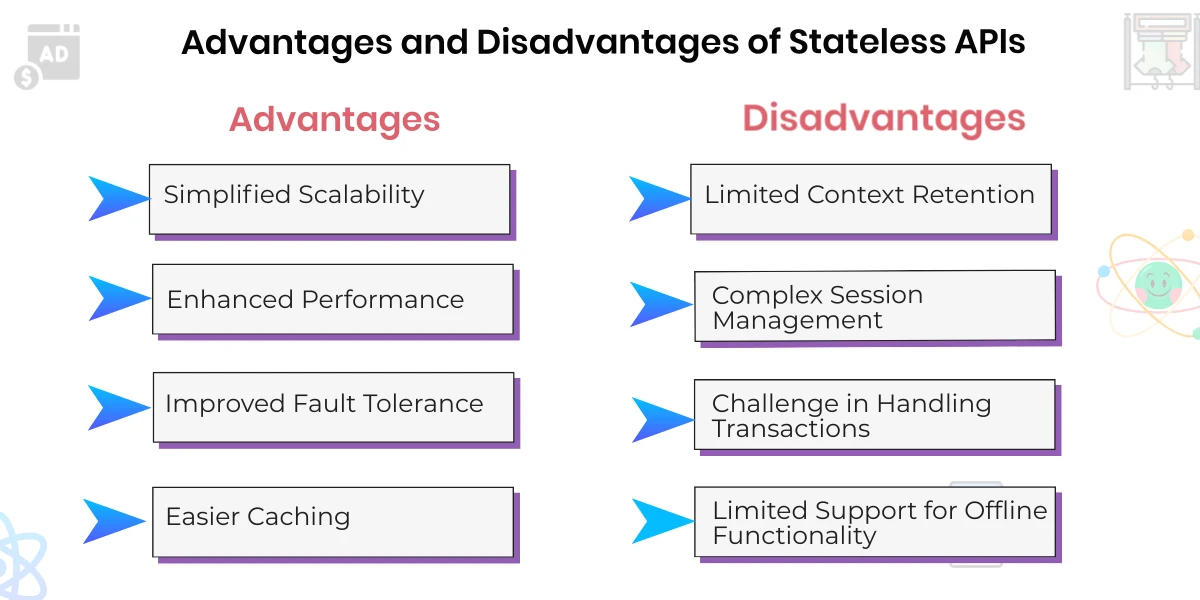
Advantages of Stateless APIs:
1. Simplified Scalability:
Stateless APIs are inherently designed for scalability. Since each request contains all the information needed, servers can effortlessly scale horizontally by distributing requests across multiple instances. This elasticity makes stateless APIs well-suited for applications experiencing varying levels of demand.
2. Enhanced Performance:
Stateless APIs promote efficiency by eliminating the need for servers to store client states. This results in faster response times and reduced server load, making them an ideal choice for applications where rapid and independent request processing is crucial.
3. Improved Fault Tolerance:
Stateless APIs simplify fault tolerance mechanisms. In the event of server failure, clients can reroute requests to another server without concerns about losing state. This enhances system resilience and ensures continuity of service even in challenging conditions.
4. Easier Caching:
Stateless APIs are conducive to caching mechanisms as responses are solely based on the input provided with each request. This simplifies caching strategies, reducing the need for complex cache invalidation mechanisms and enabling efficient use of caching infrastructure.
5. Platform Independence:
Stateless APIs foster platform independence, allowing clients to interact without being bound to specific servers. This characteristic makes them versatile, supporting a wide range of client applications with diverse technologies and platforms.
6. Simplified Testing and Debugging:
Stateless APIs facilitate easier testing and debugging. Each request is independent, making it straightforward to isolate issues and replicate scenarios for testing purposes. This accelerates the development and debugging processes.
Disadvantages of Stateless APIs:
1. Limited Context Retention:
Stateless APIs lack inherent memory of client interactions, necessitating clients to resend context information with each request. This can lead to increased data redundancy and may not be suitable for applications requiring extensive context retention, such as multi-step workflows.
2. Complex Session Management:
Managing user sessions becomes more complex in stateless APIs. Without a server-side memory of client states, developers need to employ additional mechanisms like tokens or cookies to maintain session information, introducing potential security and complexity challenges.
3. Challenge in Handling Transactions:
Stateless APIs may face challenges in handling complex transactions that span multiple requests. Coordinating such transactions requires explicit client involvement, potentially leading to increased complexity in application logic.
4. Limited Support for Offline Functionality:
Stateless APIs may not be the best fit for applications requiring robust offline functionality. Since each request is independent, clients may struggle to maintain certain states when temporarily disconnected from the server.
5. Potential Overhead in Authorization:
Stateless APIs may introduce potential overhead in authorization processes. With each request containing authentication information, there is a risk of increased data transfer, especially in scenarios where the same authorization details need to be repeatedly sent.
6. Challenges in Handling Large Payloads:
Stateless APIs may face challenges when handling large payloads, as each request contains all the necessary information. This can result in increased network traffic and potentially impact performance, especially in scenarios where extensive data needs to be transmitted.
When to Use Stateful APIs
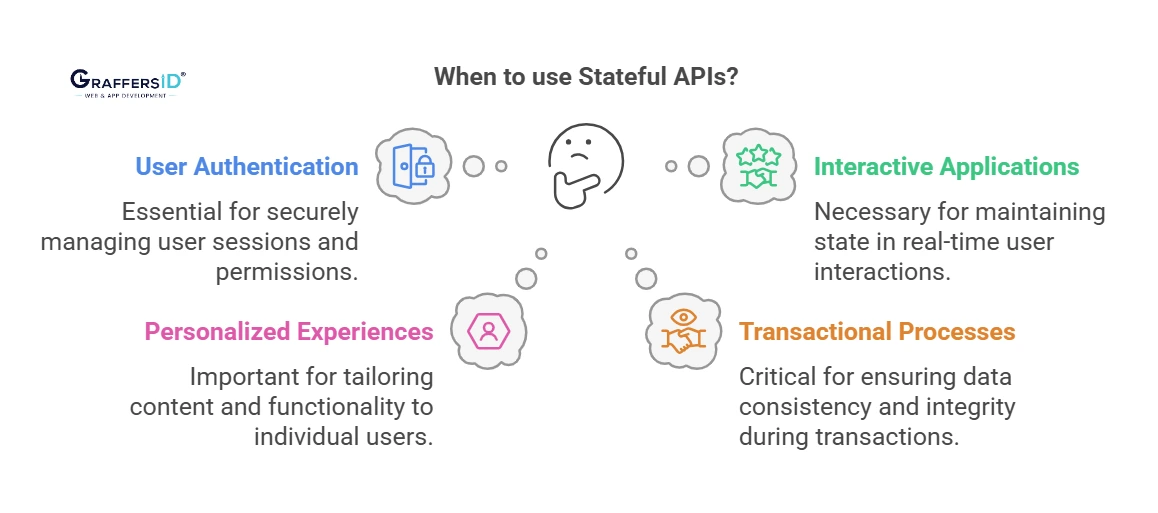
- User Authentication and Authorization: Stateful APIs are well-suited for handling user authentication and authorization, allowing for secure and persistent session management.
- Interactive Applications: Applications requiring real-time interactions or continuous sessions, such as collaborative platforms or gaming apps, benefit from the stateful nature of APIs.
- Personalized Experiences: For delivering personalized experiences based on user history and preferences, stateful APIs provide the necessary context and flexibility.
- Transactional Processes: Processes involving multi-step transactions, like checkout processes in e-commerce, benefit from the session persistence offered by stateful APIs.
When to Use Stateless APIs
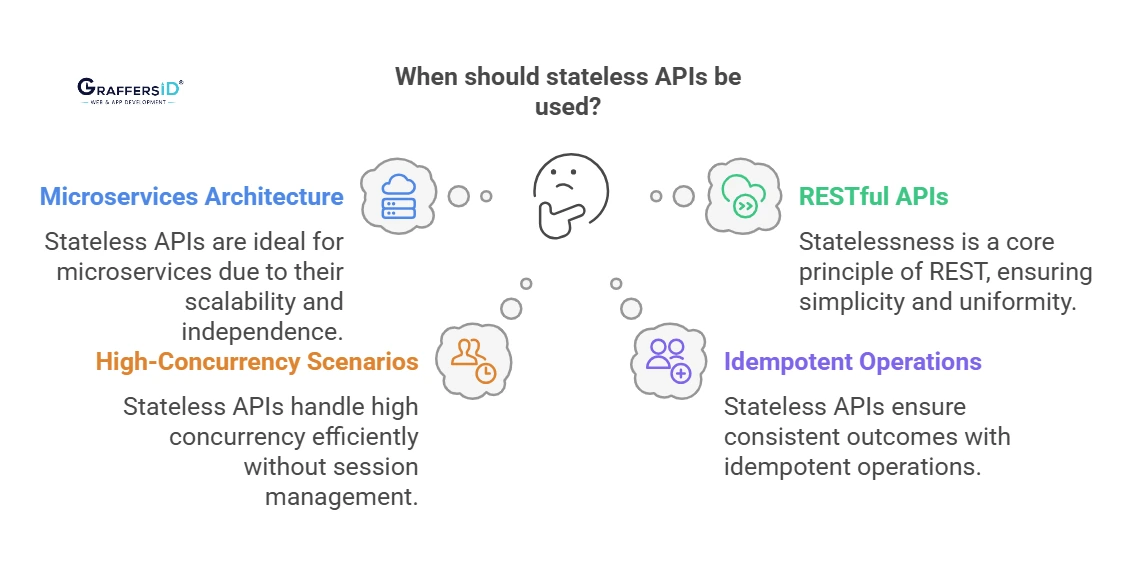
- Microservices Architecture: In a microservices architecture, where services are designed to be independent and scalable, stateless APIs are preferred. They align well with the principles of autonomy and decoupling.
- RESTful APIs: Representational State Transfer (REST) APIs, a popular architectural style for web services, often leverage stateless communication for simplicity, scalability, and compatibility with caching mechanisms.
- High-Concurrency Scenarios: Applications handling high levels of concurrent requests benefit from the scalability of stateless APIs. Each request is self-contained, reducing the burden on server resources.
- Idempotent Operations: Operations that are idempotent, meaning they produce the same result regardless of how many times they are executed, are well-suited for stateless APIs. Examples include read operations and certain data manipulation tasks.
Examples of Stateful APIs:
1. WebSocket API in Real-Time Applications:
- Use Case: Messaging and collaboration platforms like Slack, Microsoft Teams, and WhatsApp.
- Explanation: WebSocket API allows for bidirectional communication between the client and the server, maintaining an open connection. This is crucial for real-time applications where instant updates and notifications are paramount.
2. OAuth 2.0 Authentication API:
- Use Case: Social media logins, and third-party integrations.
- Explanation: OAuth 2.0, while primarily an authorization protocol, often involves maintaining a state during the authentication process. The server keeps track of the client’s state to ensure security and prevent CSRF (Cross-Site Request Forgery) attacks.
Examples of Stateless APIs:
1. RESTful APIs in Web Services:
- Use Case: Various web applications, mobile apps, and IoT devices.
- Explanation: RESTful APIs adhere to stateless principles, where each request from a client to a server is independent. The server does not store any information about the client’s state between requests, making it scalable and easy to implement.
2. Public APIs like OpenWeatherMap:
- Use Case: Weather information integration in diverse applications.
- Explanation: Stateless APIs are well-suited for scenarios where requests are self-contained. For example, OpenWeatherMap’s API allows clients to fetch weather data without the need for the server to maintain any knowledge of previous requests.
Emerging technologies impacting Stateless vs Stateful API architectures
As emerging technologies continue to redefine the digital realm, understanding their impact on stateful and stateless API architectures becomes essential for businesses aiming to stay competitive and agile in the market.
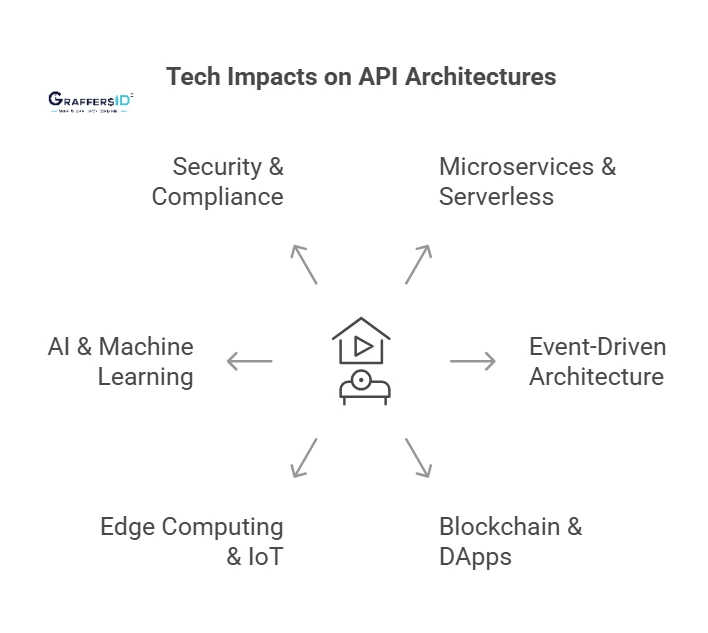
1. Rise of Microservices and Serverless Computing
Microservices architecture has gained prominence for its ability to break down monolithic applications into smaller, independently deployable services. These services communicate via APIs, often adopting stateless architectures to enable scalability and resilience. With the advent of serverless computing, where cloud providers manage the infrastructure dynamically, stateless APIs further streamline resource utilization and cost efficiency by executing functions on-demand without the need for persistent server instances.
2. Event-Driven Architecture and Asynchronous Communication
Event-driven architectures (EDA) are revolutionizing how systems interact by decoupling components and allowing them to communicate asynchronously through events. This paradigm shift challenges the traditional request-response model of APIs, favoring stateless designs that can handle a high volume of concurrent events. Technologies like Apache Kafka and AWS Lambda are empowering developers to build event-driven systems with scalable and responsive APIs, facilitating real-time data processing and analysis.
3. Blockchain and Decentralized Applications (DApps)
Blockchain technology, known for its decentralized and immutable nature, is reshaping various industries, including finance, supply chain, and healthcare. Decentralized applications (DApps) built on blockchain networks often rely on stateful APIs to manage smart contracts and interact with distributed ledgers. These APIs facilitate complex transactions while ensuring data integrity and consensus among network participants. As blockchain ecosystems evolve, interoperability and standardization of stateful API protocols become critical for seamless integration and collaboration across diverse platforms.
4. Edge Computing and IoT Devices
The proliferation of Internet of Things (IoT) devices is driving the adoption of edge computing, where data processing occurs closer to the data source rather than in centralized cloud servers. Stateful APIs play a crucial role in edge computing architectures by managing device state and facilitating real-time communication between IoT endpoints and edge gateways. As edge computing matures, the need for lightweight and efficient stateful API implementations becomes paramount to meet the latency and bandwidth constraints of distributed edge environments.
5. AI and Machine Learning Integration
Artificial intelligence (AI) and machine learning (ML) are transforming industries by enabling predictive analytics, automation, and personalized user experiences. Integrating AI/ML capabilities into applications often requires stateful APIs to manage model state, training data, and inference results. Stateful architectures support complex workflows such as model versioning, hyperparameter tuning, and incremental learning, empowering developers to build intelligent systems that continuously adapt and improve over time.
6. Security and Compliance Considerations
With the proliferation of data breaches and regulatory requirements, security and compliance remain top priorities for API architects and developers. Stateful APIs introduce additional security challenges due to session management and data persistence requirements. Implementing robust authentication, encryption, and access control mechanisms is essential to protect sensitive information and ensure compliance with privacy regulations such as GDPR and CCPA. Additionally, adopting industry standards like OAuth 2.0 and OpenID Connect can enhance interoperability and mitigate security risks in stateful API environments.
The design choices made between stateful and stateless APIs significantly influence how errors are managed and recovered within a system.
Error Handling in Stateless APIs:
Stateless APIs inherently lack context about the client’s previous interactions, making error handling more straightforward in some respects. When an error occurs, the server can return an appropriate HTTP status code (e.g., 400 for client errors or 500 for server errors) along with a descriptive error message. Since each request is self-contained, error recovery typically involves retrying the failed request or notifying the client to take corrective action.
Error Handling in Stateful APIs:
Stateful APIs introduce complexity to error handling due to the presence of client state. When an error occurs within a stateful API, the server must consider the current state of the client and the potential impact of the error on that state. Depending on the severity of the error, the server may need to rollback transactions, revert to a previous state, or initiate compensating actions to maintain data integrity. Additionally, stateful APIs may implement mechanisms such as transaction logs or checkpoints to facilitate error recovery and ensure consistency.
Challenges and Considerations to error handling and recovery
Both stateful and stateless APIs present unique challenges and considerations when it comes to error handling and recovery.
- Scalability: Stateless APIs are inherently more scalable since they do not maintain client state, allowing requests to be processed independently and in parallel. However, this scalability can pose challenges in error recovery scenarios, where the lack of context may complicate recovery efforts.
- Complexity: Stateful APIs offer advantages in terms of context retention and transaction management but introduce complexity in error handling. Developers must carefully manage client state and ensure that errors are handled gracefully without compromising data integrity or system stability.
- Performance: Stateless APIs tend to offer better performance under normal operating conditions due to their statelessness, as they require fewer resources to process each request. However, stateful APIs may exhibit higher performance in certain scenarios, particularly when handling complex transactions that benefit from context preservation.
Stateful and Stateless APIs Best Practices for Error Handling and Recovery
Regardless of whether an API is stateful or stateless, adhering to best practices in error handling and recovery is essential:
- Use descriptive error messages: Provide clear and informative error messages to help clients understand the nature of the problem and take appropriate action.
- Implement retries: Incorporate retry mechanisms to handle transient errors and improve fault tolerance.
- Maintain consistency: Ensure that error-handling strategies maintain data consistency and integrity, especially in stateful APIs where client state may be impacted.
- Monitor and log errors: Implement robust logging and monitoring systems to track errors, diagnose issues, and facilitate troubleshooting and resolution.
Considerations for Using Stateful and Stateless APIs
Stateful APIs:

Stateful APIs, characterized by their ability to preserve information about a client’s interaction with the server, introduce a layer of continuity to the user experience. By retaining the context of prior requests, these APIs facilitate a more personalized and coherent interaction. Key considerations for the utilization of stateful APIs include:
- User Sessions and Authentication: Stateful APIs prove invaluable in applications demanding user sessions and robust authentication. By storing information about a user’s login status, permissions, and preferences, stateful APIs contribute to a seamless and personalized experience.
- Complex Workflows: In scenarios involving intricate workflows or multi-step processes, stateful APIs demonstrate their prowess. By allowing the server to maintain awareness of the user’s progress, these APIs streamline interactions and mitigate the need for redundant data transfers.
- Real-time Communication: Applications requiring real-time communication, such as chat applications or online gaming platforms, find a natural ally in stateful APIs. Their capacity for establishing and sustaining a persistent connection facilitates efficient and instantaneous data exchange between the client and server.
Stateless APIs:

In stark contrast, stateless APIs operate without retaining any client information between requests. Each client request is treated in isolation, with the server processing it solely based on the data provided. The simplicity and scalability of stateless APIs come to the forefront in the following scenarios:
- Scalability and Load Balancing: Stateless APIs, renowned for their scalability, excel in applications with a vast user base. Their innate independence from the client state allows for seamless horizontal scaling and efficient load balancing, ensuring optimal performance even under heavy traffic.
- Fault Tolerance: The inherent fault tolerance of stateless APIs arises from their independent request processing. In distributed architectures, where system resilience is paramount, stateless APIs shine by isolating failures, preventing them from cascading and impacting the overall system.
- Caching Strategies: Stateless APIs seamlessly integrate with caching strategies. Since each request is devoid of dependencies on previous interactions, responses can be cached without concerns about state consistency. This results in significant performance enhancements and a reduction in server load.
Stateful APIs offer a rich, continuous user experience, stateless APIs bring simplicity and scalability to the forefront. Striking the right balance between these approaches is pivotal, empowering developers to architect systems that not only meet user needs but also align with the demands of modern software development—a delicate equilibrium that ultimately defines the success of software applications in today’s dynamic environment.
Which is more secure: Stateless vs Stateful APIs?
Both architectures offer unique security advantages and challenges, and the security posture ultimately depends on how well developers implement security best practices within each API type.
For applications requiring robust session management, stateful APIs may offer more control over security mechanisms. However, they also introduce complexities such as session storage and potential vulnerabilities.
On the other hand, stateless APIs promote scalability, reduce server-side state management overhead, and can be more resilient against certain types of attacks. Yet, they require careful consideration of authentication and token management strategies to maintain security.
Choosing the Right API for Your Project – Stateless vs Stateful APIs?
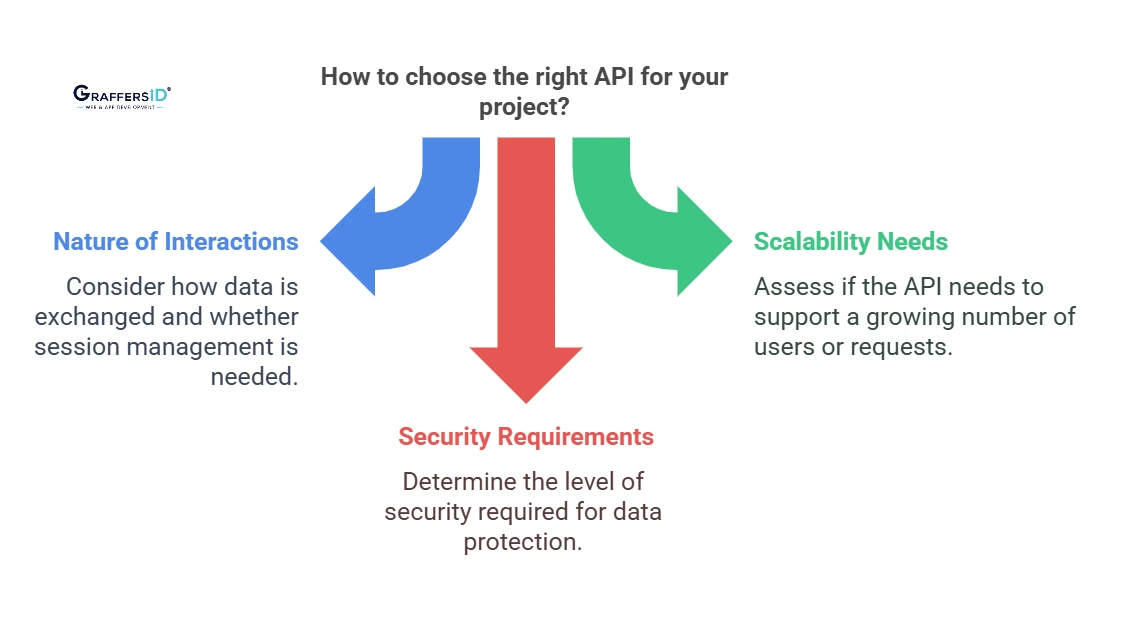
The decision between stateful and stateless APIs ultimately depends on the specific requirements of your project.
- Consider the Nature of Interactions: If your project involves continuous interactions and requires the preservation of context between requests, a stateful API may be more suitable.
- Evaluate Scalability Needs: If scalability is a top priority and your project anticipates a high volume of independent requests, a stateless API is likely the better choice.
- Factor in Security Requirements: Assess the security needs of your project. Stateful APIs, with their ability to maintain session-specific information, might be preferable in situations where enhanced security measures are essential.
Conclusion
Choosing between stateful and stateless APIs is a strategic decision that hinges on the specific requirements and constraints of a project. Stateful APIs offer seamless communication but may face challenges in scalability, while stateless APIs excel in scalability but necessitate careful management of client-side states. By grasping the intricacies of these two approaches, developers can make informed decisions, architecting robust and efficient systems tailored to their unique needs.
Elevate Your Vision, Build Success: Connect with GraffersID!
Are you on the verge of transforming your innovative ideas into a groundbreaking software project? Look no further! GraffersID is your gateway to turning dreams into reality. Our seasoned team of developers, designers, and strategists is ready to collaborate with you, ensuring that your project not only meets but exceeds expectations. From conceptualization to deployment, we are committed to guiding you through every step of the journey. Let’s embark on this transformative adventure together—connect with GraffersID and witness your software aspirations come to life. Your success story begins here.



